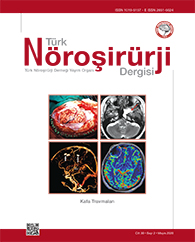Türk Nöroşirürji Dergisi
2020 , Vol 30 , Num 2
Intensive Care Management and Treatment Algorithm in Traumatic Brain Injury
1Başkent Üniversitesi Tıp Fakültesi Anesteziyoloji ve Reanimasyon Anabilim Dalı, Ankara, Türkiye
In patients with traumatic brain injury, appropriate intensive care management begins with admission. Secondary brain injury is a
condition that can develop within hours and days following primary brain injury and can be of intraparenchymal, extraparenchymal,
or systemic origin. Most importantly, it can be prevented. Traumatic brain injury cases should be followed up with a multidisciplinary
approach, mostly in the intensive care unit, especially to prevent secondary injury. In order to protect patients from secondary brain
injury, hypotension (systolic blood pressure <90 mmHg), hypoxemia (PaO2 <60 mmHg; O2 Saturation <90%), hypocapnia (PaCO2
<35 mmHg), hypercapnia (PaCO2 >45 mmHg), hypertension (systolic blood pressure >160 mmHg, or mean arterial pressure >110
mmHg), anemia (hemoglobin <10 g/L, or hematocrit <0.30), hyponatremia (serum sodium <142 mEq/L), hyperglycemia (blood sugar
>200 mg/dL), hypoglycemia (<60 mg/dL), hypo-osmolality (plasma osmolality [P Osm] <290 mOsm/Kg H2O), acid-base disturbance
(acidemia: pH <7.35; alkalemia: pH >7.45), fever (body temperature >37.5 °C) and hypothermia (body temperature <35.5 °C) should
not be allowed.
Anahtar Kelimeler :
ICU, Head trauma, Brain injury

